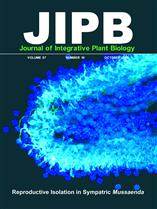Author: Qing Liu, Gezhi Shen, Keqin Peng, Zhigang Huang, Jianhua Tong, Mohammed Humayun Kabir, Jianhui Wang, Jingzhe Zhang, Genji Qin, and Langtao Xiao
Plant architecture is an important factor for crop production. Some members of microRNA156 (miR156) and their target genes SQUAMOSA Promoter-Binding Protein-Like (SPL) were identified to play essential roles in the establishment of plant architecture. However, the roles and regulation of miR156 is not well understood yet. Here, we identified a T-DNA insertion mutant Osmtd1 (Oryza sativa multi-tillering and dwarf mutant). Osmtd1 produced more tillers and displayed short stature phenotype. We determined that the dramatic morphological changes were caused by a single T-DNA insertion in Osmtd1. Further analysis revealed that the T-DNA insertion was located in the gene Os08g34258 encoding a putative inhibitor I family protein. Os08g34258 was knocked out and OsmiR156f was significantly upregulated in Osmtd1. Overexpression of Os08g34258 in Osmtd1 complemented the defects of the mutant architecture, while overexpression of OsmiR156f in wild-type rice phenocopied Osmtd1. We showed that the expression of OsSPL3, OsSPL12, and OsSPL14 were significantly downregulated in Osmtd1 or OsmiR156f overexpressed lines, indicating that OsSPL3, OsSPL12, and OsSPL14 were possibly direct target genes of OsmiR156f. Our results suggested that OsmiR156f controlled plant architecture by mediating plant stature and tiller outgrowth and may be regulated by an unknown protease inhibitor I family protein.
Liu Q, Shen G, Peng K, Huang Z, Tong J, Kabir MH, Wang J, Zhang J, Qin G, Xiao L (2015) The alteration in the architecture of a T-DNA insertion rice mutant osmtd1 is caused by up-regulation of MicroRNA156f. J Integr Plant Biol 57: 819–829 doi: 10.1111/jipb.12340




 Scan the QR code to view JIPB on WeChat
Scan the QR code to view JIPB on WeChat













